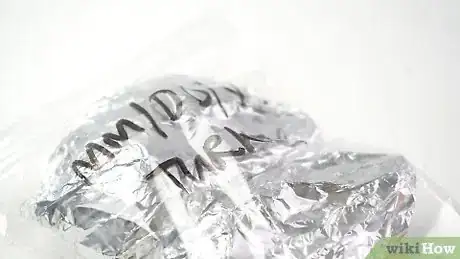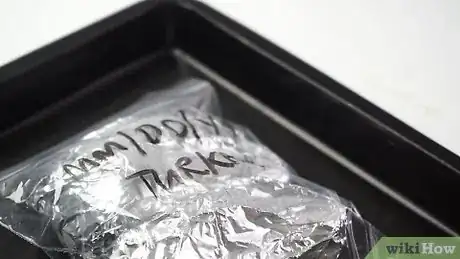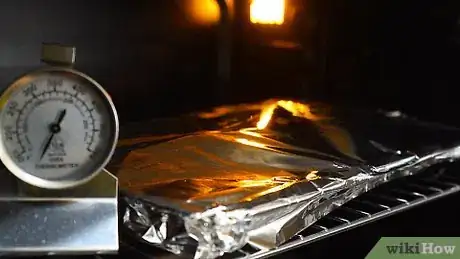This article was co-authored by wikiHow staff writer, Jessica Gibson. Jessica Gibson is a Writer and Editor who's been with wikiHow since 2014. After completing a year of art studies at the Emily Carr University in Vancouver, she graduated from Columbia College with a BA in History. Jessica also completed an MA in History from The University of Oregon in 2013.
There are 10 references cited in this article, which can be found at the bottom of the page.
The wikiHow Culinary Team also followed the article's instructions and verified that they work.
This article has been viewed 19,487 times.
Learn more...
Get the most out of your smoked turkey by storing it properly. Although smoked turkey does last a little longer than roasted turkey, it can dry out or cause other food in your fridge to smell smoky. Wrap it thoroughly and label it before tossing it in the fridge for short-term storage or putting it in the freezer for long-term keeping. Then, reheat your leftover smoked turkey safely so you can enjoy it whenever you like!
Steps
Refrigerating Smoked Turkey
-
1Plan to store the turkey within 2 hours of smoking it. If the turkey's temperature stays between 40 and 140 °F (4 and 60 °C), dangerous bacteria grow quickly. Clear space in your fridge and get out plastic wrap or shallow containers so you're ready to store the smoked turkey.[1]
-
2Cut the turkey into portions or slices to make it easier to reheat. This also gives you more flexibility when you warm up the turkey, since you can reheat just as much meat as you need. For example, cut the breast meat into slices, cut off the legs, and remove the thighs. Then, warm just the portions that you want for a single meal.[2]
- If you're preparing the turkey ahead of time to serve to a crowd, you can leave it whole. Cover the turkey tightly with plastic wrap before you refrigerate it.
Advertisement -
3Put the turkey into shallow airtight containers or seal it in plastic wrap. Food storage containers are convenient, but the turkey can leave a lingering smoky smell even after you remove the turkey and wash them. If you'd rather use something else, cover the turkey with plastic wrap. Then, wrap it in foil.[3]
- If you want to refrigerate the turkey with gravy, spoon enough gravy over it to cover the meat. This keeps the turkey moist as it chills.
-
4Label the container or foil with the date. It's really easy to forget when you put something in the fridge, which can make it harder to determine if the smoked turkey is safe to eat. Stick a label on the container that says, "smoked turkey" and the date that you put it in the fridge.[4]
- If you divided the turkey into several containers, remember to label each one.
- You don't need to buy special labels for your containers. Just tear off a piece of masking tape and write the information on it.
-
5Chill the smoked turkey in the fridge for up to 2 weeks. Smoked turkey lasts a little longer than roasted turkey since the smoke helps preserve the meat. Since the turkey will dry out the longer it's stored, it's still best to use the meat soon after you smoke it.[5]
- If you've had the smoked turkey in the fridge for less than 2 weeks and find that you can't finish it all, store the rest in the freezer.
Putting Turkey in the Freezer
-
1Carve the turkey into portions and wrap each of them in plastic wrap. Cut large pieces of smoked turkey into smaller portions or slice the meat. Then, place the portions on plastic wrap and seal them closed. Get the turkey ready to freeze within 2 hours of smoking it so harmful bacteria doesn't grow.[6]
- If you don't want to use plastic wrap, wrap the meat in butcher paper or freezer paper.
- Smaller portions of smoked turkey defrost faster than large portions, so divide the turkey if you want to save time. For example, wrap the legs in 1 portion and the sliced turkey breast in 2 separate portions.
- Don't freeze a whole smoked turkey since it's difficult to safely thaw and reheat the bird.
-
2Cover the plastic-wrapped turkey in aluminum foil. Tear off sheets of aluminum foil that are large enough to completely wrap around your turkey portions. Seal the edges closed to hold the plastic wrap in place and stop moisture from escaping as you freeze the turkey.[7]
- Wrapping the smoked turkey in several layers also protects the meat from freezer burn.
-
3Place the wrapped turkey into a freezer bag and label it. Squeeze the air out of the freezer bag before you seal it shut and then write what's in the bag and the date on the outside. The bag gives an extra layer of protection and prevents the turkey from making other things in your freezer smell smoky.[8]
- For example, write, "2 pounds (0.91 kg) sliced, smoked turkey, 7/7/20."
-
4Freeze the smoked turkey for up to 4 months. Although frozen turkey keeps indefinitely, you'll get the best texture if you use it within 4 months of putting it in the freezer.[9]
Reheating Smoked Turkey
-
1Thaw the turkey in the fridge if you stored it in the freezer. When you're ready to enjoy smoked turkey, take it out of the freezer and set it on a baking dish or rimmed sheet. Don't unwrap the turkey; just place it into the fridge and let it thaw slowly until the meat doesn't feel hard. It takes about 1 day to defrost 4 to 5 pounds (1.8 to 2.3 kg) of smoked turkey.[10]
- Once you've thawed the smoked turkey, eat it cold or reheat it. Use the meat within 4 days.
-
2Heat the turkey in the oven at 325 °F (163 °C) until the meat reaches 165 °F (74 °C). For a gentle reheating method, put your smoked turkey slices or pieces into a roasting dish and pour about 1⁄4 cup (59 ml) of water or broth into it. Preheat your oven to 325 °F (163 °C) and cover your turkey with foil. Then, heat the meat until it reaches 165 °F (74 °C) with an instant-read thermometer.[11]
- Plan on heating a pan full of turkey for about 20 to 25 minutes before you check its temperature.
-
3Microwave your turkey until it reaches 165 °F (74 °C). Place the smoked turkey on a microwave-safe container and put a microwave cover over the food. If you don't have one of these, cover the container loosely with plastic wrap, but don't let the plastic touch the meat. Then, microwave the meat 1 minute for every 1 pound (0.45 kg) you're making. Stick an instant-read meat thermometer into the thickest part of the turkey to see if it's reached 165 °F (74 °C).[12]
- If the smoked turkey's not up to temperature, keep heating it in 30-second increments until it's hot enough.
- Chemicals from the plastic can transfer to your turkey if the plastic wrap touches the food while you're microwaving it.
-
4Don't reheat the food more than once to prevent bacteria growth. Once you've warmed your smoked turkey in the oven or microwave, plan on eating it quickly. You shouldn't keep reheating leftovers or you could encourage bacteria growth.[13]
- This is why it's a good idea to divide the turkey into small portions so you can reheat only what you'll eat in 1 sitting.
Warnings
- Throw out smoked turkey that smells sour or feels slimy. Don't taste it to try to tell if it's bad since it's not worth the risk of getting sick. [15]⧼thumbs_response⧽
- Refrigerate or freeze the turkey within 2 hours of smoking it since leaving it at room temperature for longer than this causes bacteria to grow faster.[16]⧼thumbs_response⧽
Things You'll Need
Refrigerating Smoked Turkey
- Shallow airtight containers
- Plastic wrap
- Aluminum foil
- Permanent marker
Putting Turkey in the Freezer
- Airtight containers or freezer-safe storage bags
- Permanent marker
- Aluminum foil
Reheating Smoked Turkey
- Baking dish or rimmed baking sheet
- Instant-read meat thermometer
- Aluminum foil
- Microwave-safe dish, optional
- Plastic wrap, optional
References
- ↑ https://www.fsis.usda.gov/wps/portal/fsis/topics/food-safety-education/get-answers/food-safety-fact-sheets/safe-food-handling/smoking-meat-and-poultry/ct_index
- ↑ https://www.fsis.usda.gov/wps/portal/fsis/topics/food-safety-education/get-answers/food-safety-fact-sheets/safe-food-handling/smoking-meat-and-poultry/ct_index
- ↑ https://www.stilltasty.com/fooditems/index/18584
- ↑ https://www.nytimes.com/2020/01/20/smarter-living/wirecutter/organize-your-fridge-and-keep-it-neat.html
- ↑ https://nchfp.uga.edu/publications/nchfp/lit_rev/cure_smoke_pres.html
- ↑ https://www.fsis.usda.gov/wps/wcm/connect/c69aeb8f-720c-43f3-96d4-ab81286cd199/Turkey_Basics_Handling_Cooked_Dinners.pdf?MOD=AJPERES
- ↑ https://www.foodfirefriends.com/how-long-does-smoked-meat-last/#:~:text=According%20to%20the%20Food%20Safety,or%20freeze%20for%20later%20use.
- ↑ https://www.foodfirefriends.com/how-long-does-smoked-meat-last/
- ↑ https://www.fsis.usda.gov/wps/portal/fsis/topics/food-safety-education/get-answers/food-safety-fact-sheets/poultry-preparation/turkey-basics-handling-cooked-dinners/ct_index
- ↑ https://www.fsis.usda.gov/wps/portal/fsis/topics/food-safety-education/get-answers/food-safety-fact-sheets/poultry-preparation/turkey-basics-handling-cooked-dinners/ct_index
- ↑ https://www.fsis.usda.gov/wps/wcm/connect/fsis-content/internet/main/topics/food-safety-education/get-answers/food-safety-fact-sheets/poultry-preparation/lets-talk-turkey/ct_index
- ↑ https://www.fsis.usda.gov/wps/wcm/connect/fsis-content/internet/main/topics/food-safety-education/get-answers/food-safety-fact-sheets/poultry-preparation/lets-talk-turkey/ct_index
- ↑ https://www.nhs.uk/live-well/eat-well/cooking-turkey-safely/
- ↑ https://www.foodfirefriends.com/how-long-does-smoked-meat-last/
- ↑ https://www.stilltasty.com/fooditems/index/18584
- ↑ https://www.stilltasty.com/fooditems/index/18584



























































